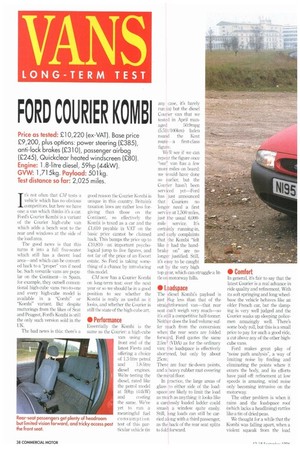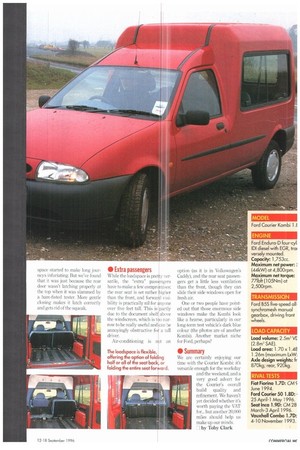VANS
Page 50

Page 51

If you've noticed an error in this article please click here to report it so we can fix it.
FORD COURIER KOMBI
It's not often that CM tests a vehicle which has no obvious competitors, but here we have one: a van which thinks its a car. Ford's Courier Kombi is a variant of the Courier high-cube van which adds a bench seat to the rear and windows at the side of the load area.
The good news is that this turns it into a full five-seater which still has a decent load area—and which can be converted back to a "proper" van if need be. Such versatile vans are popular on the Continent– in Spain, for example, they outsell conventional high-cube vans two-to-one and every high-cube model is available in a "Combi" or "Kombi" variant. But despite mutterings from the likes of Seat and Peugeot, Ford's Kombi is still the only such version sold in the UK.
The bad news is this: there's a good reason the Courier Kr imbi is unique in this country Britain's taxation laws are rather less forgiving than those on the Continent, so effectively the Kombi is taxed as a car and the £1,610 payable in VAT on the basic price cannot be claimed back. This bumps the price up to .1:1O,81a -an important psychological jump to live figures, and not far off the price of an Escort estate. So Ford is taking something of a chance by introducing this model.
CM now has a Courier Kombi on long-term test: over the next year or so we should be in a good position to see whether the Kombi is really as useful as it looks, and whether the Courier is still the state of the high-cube art.
Essentially the Kombi is the same as the Courier: a high-cube van using the front end of the latest Fiesta and offering a choice of 1.3-litre petrol and 1.8-litre diesel engines. We're testing the diesel, rated like the petrol model at 59hp (44kW) and costing the same. We've yet to run a meaningful fuel consumption test of this particular vehicle (in any case, it's barely run-in) but the diesel Courier van that we tested in April man aged 50.9mpg (5.51i t/100km) laden round the Kent route —a first-class figure.
Well see if we can repeat the figure once "our" van has a few more miles on board: we would have done so earlier, but the Courier hasn't been serviced yet—Ford has just announced that Couriers no longer need a first service at 1.500 miles, just the usual 6,000mile service. It's certainly running-in, and early complaints that the Kombi "felt like it had the handbrake on" are no longer justified Still, it's easy to be caught out by the very high top gear, which can struggle a little on motorway hills.
The diesel Kombi's payload is just 8kg less than that of the straightforward van—that rear seat can't weigh very much—so it's still a competitive half-tonner. Neither does the load volume suffer much from the conversion: when the rear seats are folded forward, Ford quotes the same 2.5m3 (VDA) as for the ordinary van: the loadspace is effectively shortened, but only by about 25cm.
There are four tie-down points, and a heavy rubber mat covering the metal floor.
In practice, the large areas of glass to either side of the loadspace are likely to limit the load as much as anything: it looks like a carelessly loaded ladder could smash a window quite easily. Still, long loads can still be carried along with a third passenger, as the back of the rear seat splits to fold forward. In general, it's fair to say that the latest Courier is a real advance in ride quality and refinement. With its soft springing and long wheelbase the vehicle behaves like an older French car, but the damping is very well judged and the Courier soaks up sleeping policemen amazingly well. There's some body roll, but this is a small price to pay for such a good ride, a cut above any of the other highcube vans.
Ford makes great play of "noise path analysis", a way of limiting noise by finding and eliminating the points where it enters the body, and its efforts have paid off: refinement at low speeds is amazing, wind noise only becoming intrusive on the motonvay The other problem is when it rains and the loadspace roof (which lacks a headlining) rattles like a tin of dried peas.
We thought for a while that the Kombi was falling apart, when a violent squeak from the load space started to make long journeys infuriating. But we've found that it was just because the rear door wasn't latching properly at the top when it was slanuned by a ham-fisted tester. More gentle closing makes it latch correctly and gets rid of the squeak.
While the loadspace is pretty versatile, the "extra" passengers have to make a few compromises: the rear seat is set rather higher than the front, and forward visibility is practically nil for anyone over five feet tall. This is partly due to the document shelf above the windscreen, which is tuo narrow to be really useful and kmn be annoyingly obstructive for a all driver.
Air-conditioning is ncian
option (as it is in Volkswagen's Caddy), and the rear seat passengers get a little less ventilation than the front, though they can slide their side windows open for fresh air.
One or two people have pointed out that those enormous side windows make the Kombi look like a hearse, particularly in our long-term test vehicle's dark blue colour (the photos are of another Kombi). Another market niche for Ford, perhaps?
We are certainly enjoying our time with the Courier Kombi: its versatile enough for the workday and the weekend, and a very oxicl advert for the Courier's overall build quality and refinement. We haven't yet decided whether it's worth paying the VAT for... but another 20,000 miles should help us make up our minds. 71by Toby Clark






















































































































